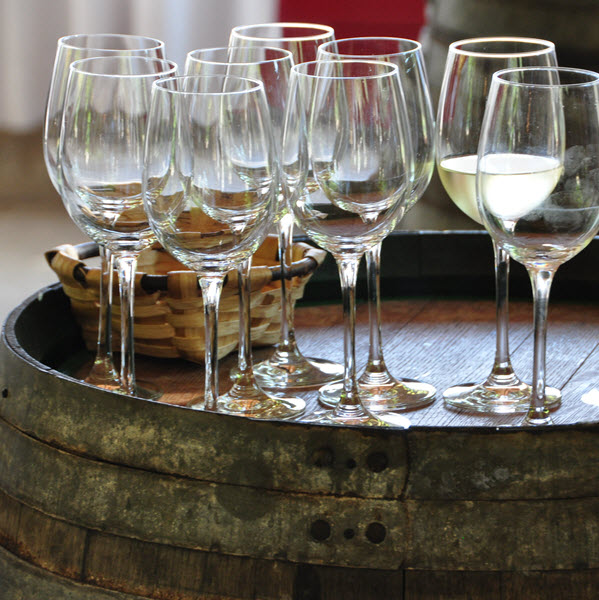Add a little yeast to some grape juice, allow the yeast to convert the grape sugar into alcohol, and you have wine. Nothing to it. Now all that needs to be done is clarify the wine to the satisfaction of the consumer and put it in a bottle. Ahhhhh… There is the problem, there is where a winemaker is called upon to make decisions and take risks that may ruin the wine.
 The problem is that the American consumer is fussy in that we do not like to see “foreign objects” in our food. We want everything nice and clean and sparkling – no haze, no cloudiness, and no sediment. Unfortunately, every time that we take something bad out of the wine we take something good out as well.
The problem is that the American consumer is fussy in that we do not like to see “foreign objects” in our food. We want everything nice and clean and sparkling – no haze, no cloudiness, and no sediment. Unfortunately, every time that we take something bad out of the wine we take something good out as well.
Once a wine has completed the fermentation, it is the job of the winemaker to render the new wine stable and clear with a minimum loss of flavor and aroma. The arsenal of tools available to accomplish this feat is somewhat limited and these tools fall into two categories: The first category includes filters that literally strain the foreign objects out when the wine is passed through some kind of strainer device. The second category is called “fining”, which involves adding an insoluble substance to the wine which attracts the foreign particle to itself (like iron filings to a magnet) and then the whole mess either settles out or is filtered out. The winemaker must analyze the problem and then choose the treatment that will accomplish the goal while doing the least damage to the wine.
When removing a simple haze, filtration is usually the first choice. Filtration damages the wine the least while doing the most to improve clarity. Some winemakers try to avoid filtration because they claim that a filter will strip some body (texture) and aroma from the wine. While that is definitely the case immediately after a filtration, numerous controlled studies have shown that a filtered wine will recover in 30 days or less, and blind taste tests of filtered vs. unfiltered wines have revealed no difference once the filtered wine has been allowed to recover. Most winemakers will agree that the negative effects of filtration are minimal and the benefits of a clear, haze-free wine far outweigh the very slight chance of degradation resulting from a filtration. So filtration is a pretty easy decision and is almost universally employed by winemakers around the world.
But the most insidious and difficult problems are the ones that cannot be seen and/or show up after the wine is bottled. Perhaps the most problematic is the difficulty associated with proteins in wine. There are soluble proteins that are found in grape juice and ultimately end up in the bottled wine. These grape proteins are similar in nature to egg albumin (egg white) in that they are initially clear and when dissolved in a wine are undetectable. But like albumin, when exposed to heat the protein molecules change their structure and become insoluble – egg albumin turns white and solidifies, and grape proteins form a haze that makes the wine look “dirty”. In the case of the grape proteins, this can happen after the bottled wine is exposed to the hot trunk of a car or stored in a hot warehouse. All of a sudden a clear wine develops a haze and becomes unsaleable; and while there is no change in the taste or aroma, the wine becomes unacceptable to the consumer.
Fortunately, there are easy tests that can be used to predict whether a wine is likely to experience “protein instability” so that a winemaker can take corrective action before the wine is bottled. If a potential protein problem is detected, the only tool available to a winemaker to eliminate the problem is the use of a fining agent, namely bentonite, which is a special clay used specifically for this problem.
The problems associated with “protein instability” vary by grape variety and vary with the year. Varieties that are prone to protein instability are Sauvignon Blanc, Gewurztraminer, and Muscat, with lesser problems associated with Riesling and Pinot Grigio. For some reason, 2013 was unusually problematic and we detected a potential problem in the Sauvignon Blanc and Muscat wines.
Since the addition of bentonite also strips body and aroma, the next step was to determine the least amount of bentonite that must be added to correct the problem. That was done as a series of lab trials using various rates of bentonite, followed by the stability test and a taste test of each of the treated wines. While there was a reduction in the potential for protein instability with each increase in bentonite, there was also a noticeable reduction in wine body and aroma with each incremental addition of the bentonite. A total elimination of the risk of protein instability was also associated with a severe loss of aroma and body – the wine became quite neutral. Unfortunately, unlike filtration, there is no recovery from these changes – bentonite fining damage is permanent.
So, the winemaker is caught in a dilemma, how much damage is acceptable vs. how much risk of protein instability do we want to take? There is no win-win. Unfortunately, the winemaker does not know if he made a correct choice until the last bottle is opened and consumed. If nobody reported a haze and nobody complained of a “watery” wine, the choice was correct. Did we make the right choice? Only time will tell.
Some people like to go to casino to experience risk, a winemaker just gets up in the morning and goes to work.
